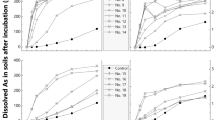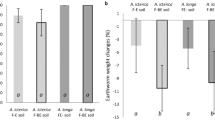Abstract
Hyperaccumulating plants are increasingly investigated in combination with EDTA addition to soil for phytoremediation of heavy metal contaminated soils. A 60-day incubation experiment was carried out to investigate the effects of heavy metal release during the decomposition of Zn-rich (15.7 mg g−1 dry weight) Arabidopsis halleri litter on C mineralization, microbial biomass C, biomass N, ATP, and adenylate energy charge (AEC). These effects were investigated in two soils with different Zn, Cu, and Pb levels, with and without EDTA addition to soil. The sole addition of Zn-rich A. halleri litter to the two soils did not increase the contents of NH4NO3 extractable Zn, only with the combined additions of EDTA and litter was there a considerable increase, being equivalent to three times the added amount in the low metal soil and to 50% in the high metal soil. Litter amendment increased the CO2 evolved; being equivalent to 44% of the added C in the two soils, but EDTA addition had no significant effect on CO2 evolution. Litter amendment resulted also in an 18% increase in microbial biomass C, 27% increase in ATP and 6% increase in AEC in the two soils, but EDTA had again no effect on these indices at both metal levels. In contrast, the sole addition of litter had no effect on microbial biomass N, but EDTA addition increased microbial biomass N on average by 49%. The application of EDTA for chelate-assisted phytoextraction should in the future consider the risk of groundwater pollution, which is intensified by resistance of EDTA to microbial decomposition.




Similar content being viewed by others
References
Abaye, D. A., Lawlor, K., Hirsch, P. R., & Brookes, P. C. (2005). Changes in the microbial community of an arable soil caused by long-term metal contamination. European Journal Soil Science, 56, 93–102.
Boucher, U., Lamy, I., Cambier, P., & Balabane, M. (2005a). Decomposition in soil microcosms of leaves of the metallophyte Arabidopsis halleri: Effect of leaf-associated heavy metals on biodegradation. Environmental Pollution, 135, 187–194.
Boucher, U., Lamy, I., Cambier, P., & Balabane, M. (2005b). Decomposition of leaves of metallophyte Arabidopsis halleri in soil microcosms: Fate of Zn and Cd from plant residues. Environmental Pollution, 135, 323–332.
Brookes, P. C., Landman, A., Pruden, G., & Jenkinson, D. S. (1985). Chloroform fumigation and the release of soil nitrogen: A rapid direct extraction method for measuring microbial biomass nitrogen in soil. Soil Biology & Biochemistry, 17, 837–842.
Chander, K., Dyckmans, J., Joergensen, R. G., Meyer, B., & Raubuch, M. (2001). Different sources of heavy metals and their long-term effects on soil microbial properties. Biology and Fertility of Soils, 34, 241–247.
Contin, M., Todd, A., & Brookes, P. C. (2001). The ATP concentration in the soil microbial biomass. Soil Biology & Biochemistry, 33, 701–704.
Di Gregorio, S., Barbafieri, M., Lampis, S., Sanangelantoni A. M., Tassi, E., & Vallini G. (2006). Combined application of Triton X-100 and Sinorhizobium sp. Pb002 inoculum for the improvement of lead phytoextraction by Brassica juncea in EDTA amended soil. Chemosphere, 63, 293–299.
Dilly, O. (2006). Ratios of microbial biomass estimates to evaluate microbial physiology in soil. Biology and Fertility of Soils, 42, 241–246.
Dyckmans, J., Chander, K., Joergensen, R. G., Priess, J., Raubuch, M., & Sehy, U. (2003). Adenylates as an estimate of microbial biomass C in different soil groups. Soil Biology & Biochemistry, 35, 1485–1491.
Elbaz, B., Shoshani-Knaani, N., David-Assael, O., Mizrachy-Dagri, T., Mizrahi, K., Saul, H., et al. (2006). High expression in leaves of the zinc hyperaccumulator Arabidopsis halleri of AhMHX, a homolog of an Arabidopsis thaliana vacuolar metal/proton exchanger. Plant, Cell & Environment, 29, 1179–1190.
Giller, K. E., Witter, E., & McGrath, S. P. (1998). Toxicity of heavy metals to microorganisms and microbial processes in Agricultural soils: A review. Soil Biology & Biochemistry, 30, 1389–1414.
Hernández-Allica, J., Becerril, J. M., Zárate, O., & Garbisu, C. (2006). Assessment of the efficiency of a metal phytoextraction process with biological indicators of soil health. Plant Soil, 281, 147–158.
Huang, J. W., Chen, J., Berti, W. R., & Cunningham, S. D. (1997). Phytoremediation of lead contaminated soils – Role of synthetic chelates in lead phytoextraction Environmental Science & Technology, 31, 800–806.
Joergensen, R. G., & Raubuch, M. (2005). Determination of adenylates and adenylate energy charge. In R. Margesin & F. Schinner (Eds.), Manual of soil analysis – Monitoring and assessing soil bioremediation (Soil Biology, Vol 5). Springer, Berlin, pp. 299–304.
Khan, K. S., Chander, K., Hartmann, G., Lamersdorf, N., & Joergensen, R. G. (2007). Sources of heavy metals and their long-term effects on microbial C, N and P relationships in soil. Water Air Soil Pollution, 181, 225–234.
Khan, K. S., & Joergensen, R. G. (2006). Decomposition of heavy metal-contaminated nettles (Urtica dioica L.) in soils differently subjected to heavy metal pollution by river sediments. Chemosphere, 65, 981–987.
Martens, R. (1992). A comparison of soil adenine nucleotide measurements by HPLC and enzymatic analysis. Soil Biology & Biochemistry, 24, 639–645.
McGrath, S. P., Lombi, E., Gray, C. W., Caille, N., Dunham, S. J., & Zhao, F. J. (2006). Field evaluation of Cd and Zn phytoextraction potential by the hyperaccumulators Thlaspi caerulescens and Arabidopsis halleri. Environmental Pollution, 141, 115–125.
Potthoff, M., Dyckmans, J., Flessa, H., Muhs, A., Beese, F., & Joergensen, R. G. (2005). Dynamics of maize (Zea mays L.) leaf straw mineralization as affected by the presence of soil and the availability of nitrogen. Soil Biology & Biochemistry, 37, 1259–1266.
Rajapaksha, R. M. C. P., Tabor-Kaplan, M. A., & Bååth, E. (2004). Metal toxicity affects fungal and bacterial activities in soil differently. Applied and Environmental Microbiology, 70, 2966–2973.
Römkens, P., Bouwman, L., Japenga, J., & Draaisma, C. (2002). Potentials and drawbacks of chelate-enhanced phytoremediation of soils. Environmental Pollution, 116, 109–121.
Salamanca, E. F., Raubuch, M., & Joergensen, R. G. (2006). Microbial reaction of secondary tropical forest soils to the addition of leaf litter. Applied Soil Ecology, 31, 53–61.
Sarret, G., Saumitou-Laprade, P., Bert, V., Proux, O., Hazemann, J. L., Traverse, A., et al. (2002). Forms of zinc accumulated in the hyperaccumulator Arabidopsis halleri. Plant Physiology, 130, 1815–1826.
Tiedje, J. M. (1975). Microbial degradation of ethylenediaminetetraacetate in soils and sediments. Applied Microbiology, 30, 327–329.
Wenzel, W. W., Unterbrunner, R., Sommer, P., & Sacco, P. (2003). Chelate-assisted phytoextraction using canola (Brassica napus L.) in outdoors pot and lysimeter experiment. Plant Soil, 249, 83–96.
Witter, E., & Kanal, A. (1998). Characteristics of the soil microbial biomass in soils from a long-term field experiment with different levels of C input. Applied Soil Ecology, 10, 37–49.
Wu, J., Joergensen, R. G., Pommerening, B., Chaussod, R., & Brookes, P. C. (1990). Measurement of soil microbial biomass-C by fumigation-extraction – an automated procedure. Soil Biology & Biochemistry, 22, 1167–1169.
Zhang, L., Angle, J. S., & Chaney, R. L. (2007). Do high-nickel leaves shed by the nickel hyperaccumulator Alyssum murale inhibit seed germination of competing plants?. New Phytologist, 173, 509–516.
Zhang, L., Angle, J. S., Delorme, T., & Chaney, R. L. (2005). Degradation of Alyssum murale biomass in soil. International Journal of Phytoremediation, 7, 169–176.
Acknowledgements
Krishan Chander thanks the Alexander-von-Humboldt Foundation for financial support. We thank Gabriele Dormann and Manuel Renneberg for technical assistance. We also thank Mick Locke for carefully correcting our English.
Author information
Authors and Affiliations
Corresponding author
Rights and permissions
About this article
Cite this article
Chander, K., Joergensen, R.G. Decomposition of Zn-rich Arabidopsis halleri Litter in Low and High Metal Soil in the Presence and Absence of EDTA. Water Air Soil Pollut 188, 195–204 (2008). https://doi.org/10.1007/s11270-007-9535-5
Received:
Accepted:
Published:
Issue Date:
DOI: https://doi.org/10.1007/s11270-007-9535-5




